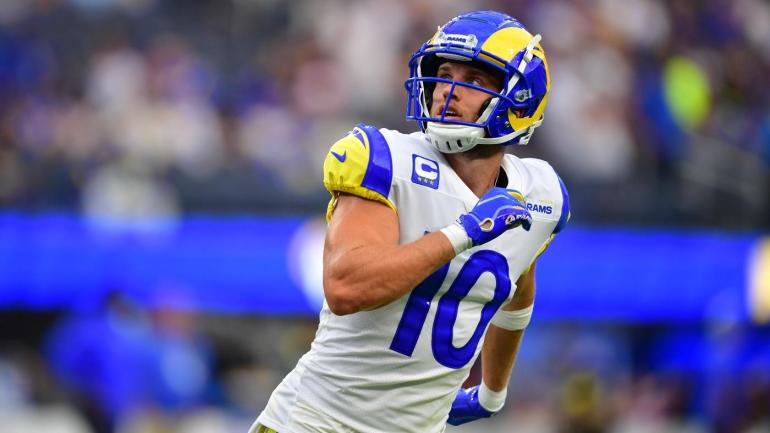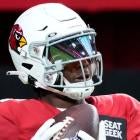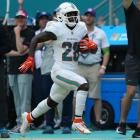
The decision that will drive your wide receiver strategy in PPR will be based on how you feel about Tier 1 running backs (like Christian McCaffrey, Austin Ekeler and even Bijan Robinson) and Tier 1 tight ends (Travis Kelce and absolutely no one else). If you crave one of them, you're probably passing up a shot at a Tier 1 receiver (you may be able to snag one with an early Round 2 pick but don't count on it).
Otherwise, you're not just playing it safe by taking a receiver in Round 1, you're also playing the odds that you'll score more Fantasy points with that pick.
The most popular positions in Fantasy are running backs and wide receivers, and there's been a tug-of-war between them for Fantasy supremacy for years. The war has been won, for now, by receivers, but that's ONLY if your league counts receptions for anything. In Point Per Reception (PPR) formats, your decision to go with a receiver or a running back in Round 1 might be made easier after checking this out:
| 2022 | WR | RB |
| Players with 20+ PPR per game average | 4 | 2 |
| Players with 15+ PPR per game average | 13 | 10 |
| Players with 11+ PPR per game average | 39 | 30 |
| PPR per-game average of top-12 | 17.0 | 16.6 |
| PPR per-game average of 13-24 | 12.9 | 11.8 |
In five different meaningful categories, receivers outperformed running backs in 2022.
It was even more in favor of receivers in 2021 -- the top-12 wideouts averaged 17.3 PPR points per game compared to 15.0 for running backs, and the No. 2 wideouts averaged 13.3 PPR points per game versus 11.0 for their rushing counterparts. Injuries obviously play a role every year, but it's correctly assumed that running backs are more fragile than wide receivers.
So in PPR leagues, receivers are kings in the first few rounds.
But in leagues where catches don't count, they're not there and may never be.
| 2022 | WR | RB |
| Players with 15+ NON per game average | 0 | 4 |
| Players with 11+ NON per game average | 9 | 16 |
| Players with 9+ NON per game average | 20 | 29 |
| NON per-game average of top-12 | 11.7 | 13.7 |
| NON per-game average of 13-24 | 9 | 10.3 |
It's the exact opposite of the PPR chart, which is kind of obvious since the receptions that receivers ultimately need in order to produce numbers don't count for squat, and the touchdowns and yardage that the top running backs get dominate pass-catchers. It's much easier to go with a running back in Round 1, if not Rounds 1 and 2, in non-PPR leagues.
Once you get into the early-middle rounds, taking receivers is based less on want and more on what else is available to you. Not many people go into a draft getting psyched for wideouts in Rounds 4 through 6. Sometimes you draft starters there because you pick up studs at other positions earlier. I'd argue that the receivers in that range are mostly as intriguing as the running backs there, but not as alluring as the quarterbacks you could find.
Where receivers really win out are in Rounds 7 through 10. It's not so much about the depth there as it is about the potential starters you'll find compared to most other players regardless of position. Like, if I had to get a starter or two for my team in Rounds 7 through 10, the position with the easiest-to-accept choices is definitely wide receiver. This is something you could weave into your strategy -- almost assume you'll be OK finding that WR3, if not a low-end WR2 if you're a little desperate -- in that range.
The reason for this? The league's offenses are spreading the ball around, creating opportunities for plenty of non-No. 1 targets to rake in 60 or 70 yards on four or five catches. You will find wideouts who could pick up those kinds of numbers on waivers from week to week unless you're in a league with deep benches. It's why when I draft, I barely have any wide receiver depth -- I can find guys when I need them off the waiver wire. I'd rather spend the majority of my picks on running backs and hope I hit a lottery ticket.

Fantasy Football Today Newsletter
Know What Your Friends Don't
Get tips, advice and news to win your league - all from the FFT podcast team.
Thanks for signing up!
Keep an eye on your inbox.
Sorry!
There was an error processing your subscription.
DAVE'S FAVORITE STRATEGY AT WR: I won't pass up any player that carries sky-high upside, be it any position in any round. But once those players are gone (and they're usually gone very quickly), I'll lean toward taking a wide receiver only if there isn't a player at a different position I need desperately to fill a lineup spot. Then once I have four or five receivers, I'm not picking any more unless it's someone with big-time upside right at the start of the season.
Wide receiver PPR tiers (updated 8/4)
J. Jefferson
MIN
Justin Jefferson
MIN
|
J. Chase
CIN
Ja'Marr Chase
CIN
|
C. Kupp
LAR
Cooper Kupp
LAR
|
T. Hill
MIA
Tyreek Hill
MIA
|
S. Diggs
HOU
Stefon Diggs
HOU
|
C. Lamb
DAL
CeeDee Lamb
DAL
|
D. Adams
LV
Davante Adams
LV
|
A. Brown
PHI
A.J. Brown
PHI
|
A. St. Brown
DET
Amon-Ra St. Brown
DET
|
G. Wilson
NYJ
Garrett Wilson
NYJ
|
J. Waddle
MIA
Jaylen Waddle
MIA
|
D. Smith
PHI
DeVonta Smith
PHI
|
T. Higgins
CIN
Tee Higgins
CIN
|
C. Olave
NO
Chris Olave
NO
|
J. Jeudy
CLE
Jerry Jeudy
CLE
|
K. Allen
CHI
Keenan Allen
CHI
|
D. Moore
CHI
D.J. Moore
CHI
|
C. Ridley
TEN
Calvin Ridley
TEN
|
D. Hopkins
TEN
DeAndre Hopkins
TEN
|
D. Samuel
SF
Deebo Samuel
SF
|
C. Watson
GB
Christian Watson
GB
|
D. Metcalf
SEA
DK Metcalf
SEA
|
A. Cooper
CLE
Amari Cooper
CLE
|
T. McLaurin
WAS
Terry McLaurin
WAS
|
D. Johnson
CAR
Diontae Johnson
CAR
|
D. London
ATL
Drake London
ATL
|
C. Kirk
JAC
Christian Kirk
JAC
|
M. Williams
NYJ
Mike Williams
NYJ
|
C. Godwin
TB
Chris Godwin
TB
|
M. Brown
KC
Marquise Brown
KC
|
B. Aiyuk
SF
Brandon Aiyuk
SF
|
T. Lockett
SEA
Tyler Lockett
SEA
|
M. Evans
TB
Mike Evans
TB
|
G. Pickens
PIT
George Pickens
PIT
|
M. Pittman
IND
Michael Pittman
IND
|
J. Dotson
WAS
Jahan Dotson
WAS
|
G. Davis
JAC
Gabe Davis
JAC
|
J. Addison
MIN
Jordan Addison
MIN
|
M. Thomas
NO
Michael Thomas
NO
|
Z. Flowers
BAL
Zay Flowers
BAL
|
J. Smith-Njigba
SEA
Jaxon Smith-Njigba
SEA
|
S. Moore
KC
Skyy Moore
KC
|
B. Cooks
DAL
Brandin Cooks
DAL
|
J. Williams
DET
Jameson Williams
DET
|
T. Burks
TEN
Treylon Burks
TEN
|
R. Moore
ATL
Rondale Moore
ATL
|
E. Moore
CLE
Elijah Moore
CLE
|
R. Bateman
BAL
Rashod Bateman
BAL
|
J. Meyers
LV
Jakobi Meyers
LV
|
C. Sutton
DEN
Courtland Sutton
DEN
|
A. Thielen
CAR
Adam Thielen
CAR
|
R. Doubs
GB
Romeo Doubs
GB
|
Q. Johnston
LAC
Quentin Johnston
LAC
|
K. Toney
KC
Kadarius Toney
KC
|
I. Hodgins
NYG
Isaiah Hodgins
NYG
|
N. Collins
HOU
Nico Collins
HOU
|
J. Metchie III
HOU
John Metchie III
HOU
|
O. Beckham Jr.
MIA
Odell Beckham Jr.
MIA
|
A. Lazard
NYJ
Allen Lazard
NYJ
|
D. Chark
LAC
D.J. Chark
LAC
|
J. Mingo
CAR
Jonathan Mingo
CAR
|
Wide receiver non-PPR tiers (updated 8/4)
J. Jefferson
MIN
Justin Jefferson
MIN
|
J. Chase
CIN
Ja'Marr Chase
CIN
|
T. Hill
MIA
Tyreek Hill
MIA
|
S. Diggs
HOU
Stefon Diggs
HOU
|
C. Kupp
LAR
Cooper Kupp
LAR
|
C. Lamb
DAL
CeeDee Lamb
DAL
|
A. Brown
PHI
A.J. Brown
PHI
|
D. Adams
LV
Davante Adams
LV
|
G. Wilson
NYJ
Garrett Wilson
NYJ
|
J. Waddle
MIA
Jaylen Waddle
MIA
|
A. St. Brown
DET
Amon-Ra St. Brown
DET
|
D. Smith
PHI
DeVonta Smith
PHI
|
T. Higgins
CIN
Tee Higgins
CIN
|
C. Olave
NO
Chris Olave
NO
|
C. Ridley
TEN
Calvin Ridley
TEN
|
J. Jeudy
CLE
Jerry Jeudy
CLE
|
C. Watson
GB
Christian Watson
GB
|
D. Metcalf
SEA
DK Metcalf
SEA
|
D. Moore
CHI
D.J. Moore
CHI
|
D. Samuel
SF
Deebo Samuel
SF
|
A. Cooper
CLE
Amari Cooper
CLE
|
K. Allen
CHI
Keenan Allen
CHI
|
T. McLaurin
WAS
Terry McLaurin
WAS
|
D. Hopkins
TEN
DeAndre Hopkins
TEN
|
D. London
ATL
Drake London
ATL
|
D. Johnson
CAR
Diontae Johnson
CAR
|
M. Williams
NYJ
Mike Williams
NYJ
|
T. Lockett
SEA
Tyler Lockett
SEA
|
M. Brown
KC
Marquise Brown
KC
|
B. Aiyuk
SF
Brandon Aiyuk
SF
|
M. Evans
TB
Mike Evans
TB
|
C. Godwin
TB
Chris Godwin
TB
|
G. Pickens
PIT
George Pickens
PIT
|
J. Dotson
WAS
Jahan Dotson
WAS
|
M. Pittman
IND
Michael Pittman
IND
|
C. Kirk
JAC
Christian Kirk
JAC
|
G. Davis
JAC
Gabe Davis
JAC
|
J. Addison
MIN
Jordan Addison
MIN
|
M. Thomas
NO
Michael Thomas
NO
|
S. Moore
KC
Skyy Moore
KC
|
J. Williams
DET
Jameson Williams
DET
|
Z. Flowers
BAL
Zay Flowers
BAL
|
B. Cooks
DAL
Brandin Cooks
DAL
|
J. Smith-Njigba
SEA
Jaxon Smith-Njigba
SEA
|
Q. Johnston
LAC
Quentin Johnston
LAC
|
R. Bateman
BAL
Rashod Bateman
BAL
|
T. Burks
TEN
Treylon Burks
TEN
|
C. Sutton
DEN
Courtland Sutton
DEN
|
E. Moore
CLE
Elijah Moore
CLE
|
R. Doubs
GB
Romeo Doubs
GB
|
R. Moore
ATL
Rondale Moore
ATL
|
K. Toney
KC
Kadarius Toney
KC
|
I. Hodgins
NYG
Isaiah Hodgins
NYG
|
J. Meyers
LV
Jakobi Meyers
LV
|
O. Beckham Jr.
MIA
Odell Beckham Jr.
MIA
|
N. Collins
HOU
Nico Collins
HOU
|
A. Thielen
CAR
Adam Thielen
CAR
|
J. Metchie III
HOU
John Metchie III
HOU
|
D. Chark
LAC
D.J. Chark
LAC
|
A. Lazard
NYJ
Allen Lazard
NYJ
|
J. Mingo
CAR
Jonathan Mingo
CAR
|
Which sleepers, breakouts and busts should you target and fade, and which QB shocks the NFL with a top-10 performance? Visit SportsLine now to get cheat sheets for every single position, all from the model that nailed Deebo Samuel as a bust last year, and find out.






















